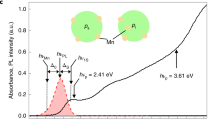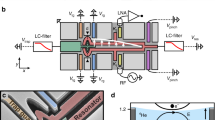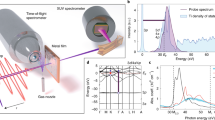Abstract
The strength of radiative transitions in atoms is governed by selection rules that depend on the occupation of atomic orbitals with electrons1. Experiments have shown2,3,4,5 similar electron occupation of the quantized energy levels in semiconductor quantum dots—often described as artificial atoms. But unlike real atoms, the confinement potential of quantum dots is anisotropic, and the electrons can easily couple with phonons of the material6. Here we report electrical pump-and-probe experiments that probe the allowed and ‘forbidden’ transitions between energy levels under phonon emission in quantum dots with one or two electrons (artificial hydrogen and helium atoms). The forbidden transitions are in fact allowed by higher-order processes where electrons flip their spin. We find that the relaxation time is about 200?µs for forbidden transitions, 4 to 5 orders of magnitude longer than for allowed transitions. This indicates that the spin degree of freedom is well separated from the orbital degree of freedom, and that the total spin in the quantum dots is an excellent quantum number. This is an encouraging result for potential applications of quantum dots as basic entities for spin-based quantum information storage.
This is a preview of subscription content, access via your institution
Access options
Subscribe to this journal
Receive 51 print issues and online access
$199.00 per year
only $3.90 per issue
Buy this article
- Purchase on Springer Link
- Instant access to full article PDF
Prices may be subject to local taxes which are calculated during checkout



Similar content being viewed by others
References
Bethe, H. A. & Salpeter, E. E. Quantum Mechanics of One- and Two-Electron Atoms (Springer, Berlin, 1957)
Kouwenhoven, L. P., et al. in Mesoscopic Electron Transport NATO ASI series E 345 (eds Sohn, L. L., Kouwenhoven, L. P. & Schön, G.) 105–214 (Kluwer, Dordrecht, 1997)
Ashoori, R. C. et al. Single-electron capacitance spectroscopy of discrete quantum levels. Phys. Rev. Lett. 68, 3088–3091 (1992)
Tarucha, S., Austing, D. G., Honda, T., van der Hage, R. J. & Kouwenhoven, L. P. Shell filling and spin effects in a few electron quantum dot. Phys. Rev. Lett. 77, 3613–3616 (1996)
Kouwenhoven, L. P. et al. Excitation spectra of circular, few-electron quantum dots. Science 278, 1788–1792 (1997)
Fujisawa, T. et al. Spontaneous emission spectrum in double quantum dot devices. Science 282, 932–935 (1998)
Tokura, Y., Sasaki, S., Austing, D. G. & Tarucha, S. Excitation spectra and exchange interactions in circular and elliptical quantum dots. Physica B 298, 260–264 (2001)
Matagne, P., Leburton, J. P., Austing, D. G. & Tarucha, S. Shell charging and spin-filling sequences in realistic vertical quantum dots. Phys. Rev. B 65, 085325 (2002)
Fujisawa, T., Tokura, Y. & Hirayama, Y. Transient current spectroscopy of a quantum dot in the Coulomb blockade regime. Phys. Rev. B 63, 081304 (2001)
Fujisawa, T., Austing, D. G., Tokura, Y., Hirayama, Y. & Tarucha, S. Non-equilibrium transport through a vertical quantum dot in the absence of spin-flip energy relaxation. Phys. Rev. Lett. 88, 236802 (2002)
Benisty, H., Sotomayer-Torres, C. M. & Weisbuch, C. Intrinsic mechanism for the poor luminescence properties of quantum-box systems. Phys. Rev. B 44, 10945–10948 (1991)
Seeger, K. Semiconductor Physics: An Introduction 153–213 (Springer, Berlin, 1985)
Bockelmann, U. Phonon scattering between zero-dimensional electronic states: Spatial versus Landau quantization. Phys. Rev. B 50, 17271–17279 (1994)
Averin, D. V. & Nazarov, Yu. V. in Single Charge Tunneling: Coulomb Blockade Phenomena in Nanostructures (eds Grabert, H. & Devoret, M. H.) 217–247 (Plenum and NATO Scientific Affairs Division, New York, 1992)
Eto, M. Electronic states and transport phenomena in quantum dot systems. Jpn J. Appl. Phys. 1 40, 1929–1935 (2001)
Sukhorukov, E. V., Burkard, G., Loss, D. . Phys. Rev. B 63, 125315 (2001)
De Franceschi, S. et al. Electron cotunneling in a semiconductor quantum dot. Phys. Rev. Lett. 86, 878–881 (2001)
Pikus, G. E. & Titkov, A. N. in Optical Orientation (eds Meier, F. & Zakharchenya, B. P.) 73–131 (Elsevier, Amsterdam, 1984)
Khaetskii, A. V. & Nazarov, Yu. V. Spin relaxation in semiconductor quantum dots. Phys. Rev. B 61, 12639–12642 (2000)
Halperin, W. P. Quantum size effects in metal particles. Rev. Mod. Phys. 58, 533–606 (1986)
Bychkov, Yu. A. & Rashba, E. I. Properties of a 2D electron gas with lifted spectral degeneracy. JETP Lett. 39, 78–81 (1984)
Loss, D. & DiVincenzo, D. P. Quantum computation with quantum dots. Phys. Rev. A 57, 120–126 (1998)
Recher, P., Sukhorukov, E. V. & Loss, D. Quantum dot as spin filter and spin memory. Phys. Rev. Lett. 85, 1962–1965 (2000)
Ciorga, M. et al. Readout of a single electron spin based quantum bit by current detection. Physica E 11, 35–40 (2001)
Seck, M., Potemski, M. & Wyder, P. High-field spin resonance of weakly bound electrons in GaAs. Phys. Rev. B 56, 7422–7427 (1997)
Gupta, J. A., Knobel, R., Samarth, N. & Awschalom, D. D. Ultrafast manipulation of electron spin coherence. Science 292, 2458–2461 (2001)
Kavokin, K. V. Anisotropic exchange interaction of localized conduction-band electrons in semiconductors. Phys. Rev. B 64, 075305 (2001)
Acknowledgements
We thank G. E. W. Bauer, T. Honda, T. Inoshita, A. V. Khaetskii and L. P. Kouwenhoven for discussions and help.
Author information
Authors and Affiliations
Corresponding author
Ethics declarations
Competing interests
The authors declare that they have no competing financial interests.
Rights and permissions
About this article
Cite this article
Fujisawa, T., Austing, D., Tokura, Y. et al. Allowed and forbidden transitions in artificial hydrogen and helium atoms. Nature 419, 278–281 (2002). https://doi.org/10.1038/nature00976
Received:
Accepted:
Issue Date:
DOI: https://doi.org/10.1038/nature00976
This article is cited by
-
Review of performance metrics of spin qubits in gated semiconducting nanostructures
Nature Reviews Physics (2022)
-
Spin relaxation in a single-electron graphene quantum dot
Nature Communications (2022)
-
Quantum circuit optimization using quantum Karnaugh map
Scientific Reports (2020)
-
Numerical solution of the Schrödinger equation in polar coordinates using the finite-difference time-domain method
Journal of Computational Electronics (2020)
-
Single hole spin relaxation probed by fast single-shot latched charge sensing
Communications Physics (2019)
Comments
By submitting a comment you agree to abide by our Terms and Community Guidelines. If you find something abusive or that does not comply with our terms or guidelines please flag it as inappropriate.



